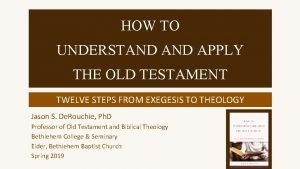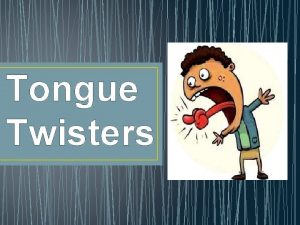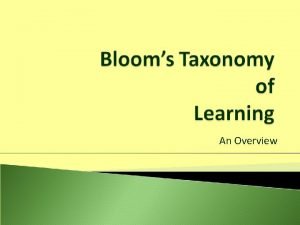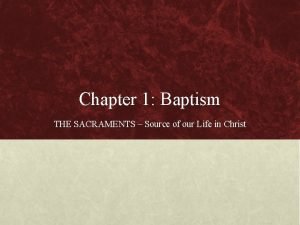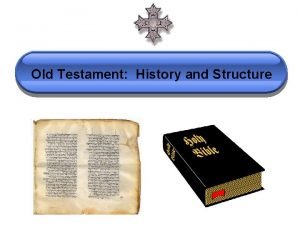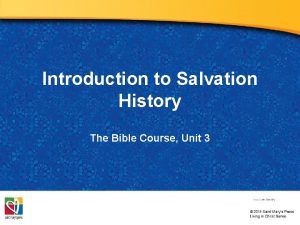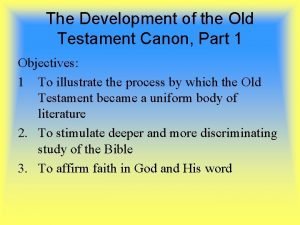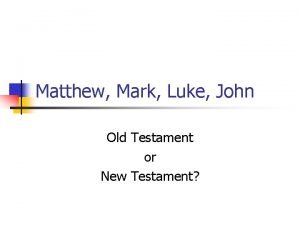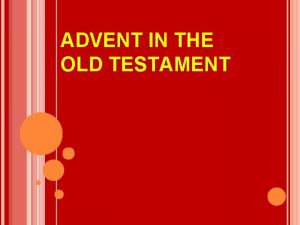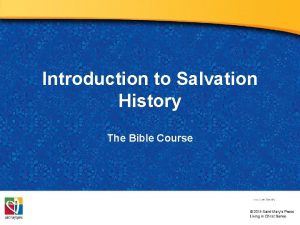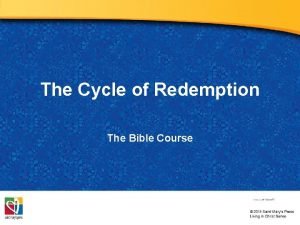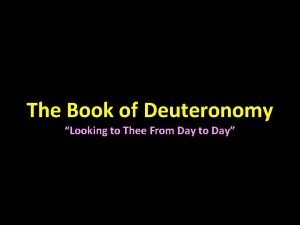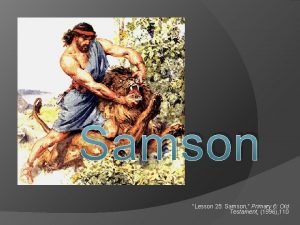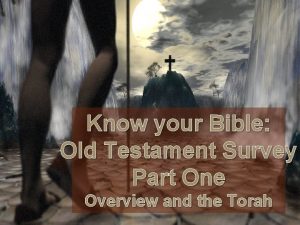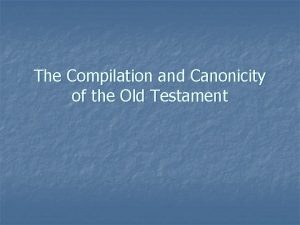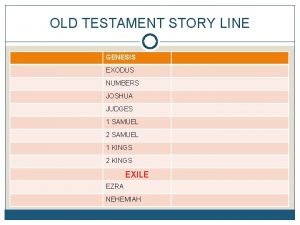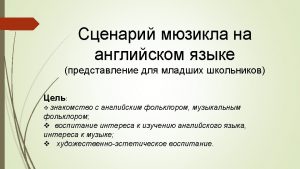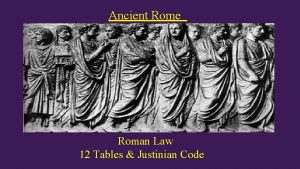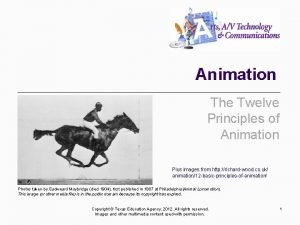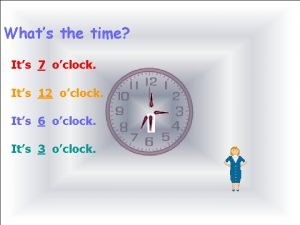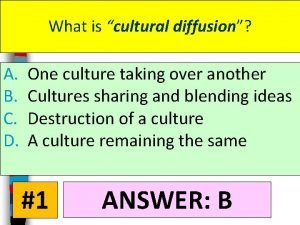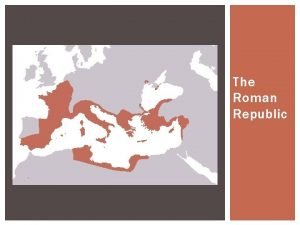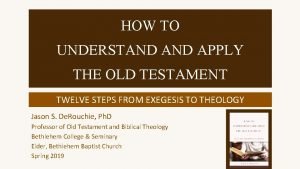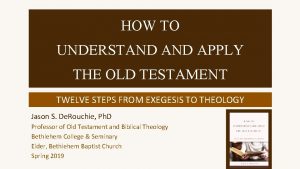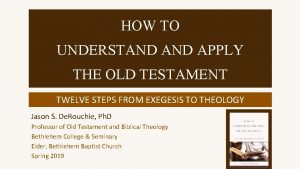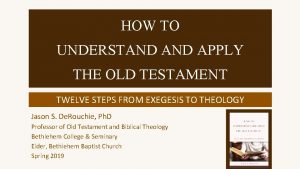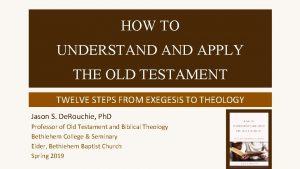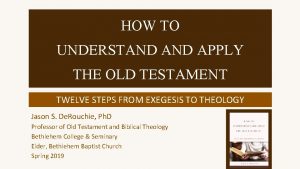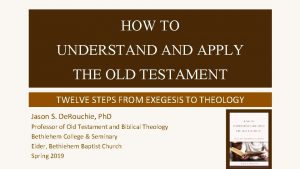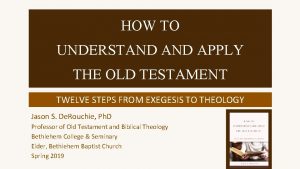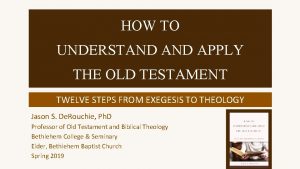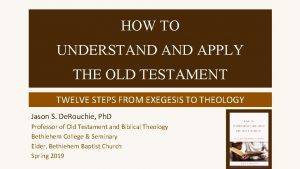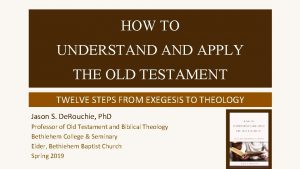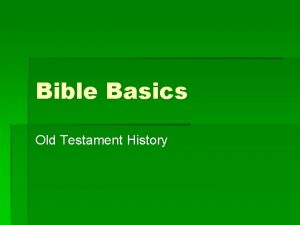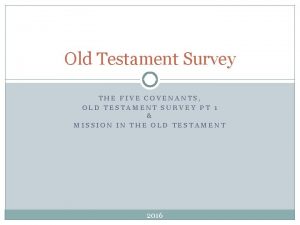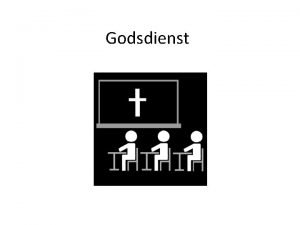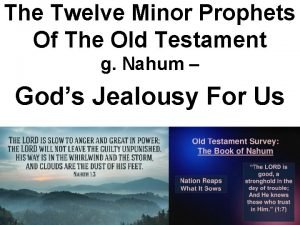HOW TO UNDERSTAND APPLY THE OLD TESTAMENT TWELVE








































- Slides: 40

HOW TO UNDERSTAND APPLY THE OLD TESTAMENT TWELVE STEPS FROM EXEGESIS TO THEOLOGY Jason S. De. Rouchie, Ph. D Professor of Old Testament and Biblical Theology Bethlehem College & Seminary Elder, Bethlehem Baptist Church Spring 2019

STEPS IN THE JOURNEY q Part 1: Text q Part 2: Observation – “How is the passage communicated? ” 5. 6. 7. Clause and Text Grammar Argument Tracing Word and Concept Studies q Part 3: Context q Part 4: Meaning q Part 5: Application

6. ARGUMENT TRACING Goal: Finish tracing the literary argument and create a message-driven outline that is tied to the passage’s main point. q Step 1: Create an Argument Diagram q Step 2: Draft an Exegetical Outline

Step 1: Create an Argument Diagram q Key Tool: www. biblearc. com q Distinguish propositions, whether full clauses or adverbial phrases. v Clause: A grammatical construction made up of a subject and its predicate with a possible coordinating or subordinating conjunction and various modifiers. v Adverbial Phrase: A group of words that fills an adverbial slot in a clause.

q Identify the semantic relationship between propositions. v Coordinate relationships: Those that stand side-by-side, whether operating independently in series, in progression pointing to a climax, as alternative possibilities of a given situation, or as both true or both false. v Subordinate relationships: Always have a main clause or text unit and then another that restates, stands distinct from, or stands contrary to the main clause or text.

Create an Argument Diagram or “Arc” COORDINATE

Create an Argument Diagram or “Arc” COORDINATE Series (S) – “Ezra likes basketball and enjoys soccer. ” (signal: “and, likewise”)

Create an Argument Diagram or “Arc” COORDINATE Series (S) – “Ezra likes basketball and enjoys soccer. ” (signal: “and, likewise”) Progression (P) – “Ben let go of the branch and then fell to the ground. ” (signal: “then, and, furthermore”)

Create an Argument Diagram or “Arc” COORDINATE Series (S) – “Ezra likes basketball and enjoys soccer. ” (signal: “and, likewise”) Progression (P) – “Ben let go of the branch and then fell to the ground. ” (signal: “then, and, furthermore”) Alternate (A) – “Emily couldn’t decide whether ‘A’ or ‘B’ was right. ” (signal: “or, but, while, on the other hand”)

Create an Argument Diagram or “Arc” COORDINATE Series (S) – “Ezra likes basketball and enjoys soccer. ” (signal: “and, likewise”) Progression (P) – “Ben let go of the branch and then fell to the ground. ” (signal: “then, and, furthermore”) Alternate (A) – “Emily couldn’t decide whether ‘A’ or ‘B’ was right. ” (signal: “or, but, while, on the other hand”) Both-And (B&) – “Joey wanted both pizza and popcorn. ” (signal: “both … and, neither … nor”)

SUBORDINATE Restatement

SUBORDINATE Restatement Action-Manner or Means (Ac/Mn) – “Grandpa walked with limp” vs. “Grandma walked with a cane” (signal: “in that, by + participles”)

SUBORDINATE Restatement Action-Manner or Means (Ac/Mn) – “Grandpa walked with limp” vs. “Grandma walked with a cane” (signal: “in that, by + participles”) Comparison (Cf) – “Isaac looks a lot like his dad. ” (signal: “even as, as … so, like, just as”)

SUBORDINATE Restatement Action-Manner or Means (Ac/Mn) – “Grandpa walked with limp” vs. “Grandma walked with a cane” (signal: “in that, by + participles”) Comparison (Cf) – “Isaac looks a lot like his dad. ” (signal: “even as, as … so, like, just as”) Negative-Positive (–/+) – “For toppings choose not the pepperoni but the green pepper. ” (signal: “not … but”)

SUBORDINATE Restatement Action-Manner or Means (Ac/Mn) – “Grandpa walked with limp” vs. “Grandma walked with a cane” (signal: “in that, by + participles”) Comparison (Cf) – “Isaac looks a lot like his dad. ” (signal: “even as, as … so, like, just as”) Negative-Positive (–/+) – “For toppings choose not the pepperoni but the green pepper. ” (signal: “not … but”) Question-Answer (Q/A) – “Do you understand his teaching? ” (signal: ? )

SUBORDINATE Restatement Action-Manner or Means (Ac/Mn) – “Grandpa walked with limp” vs. “Grandma walked with a cane” (signal: “in that, by + participles”) Comparison (Cf) – “Isaac looks a lot like his dad. ” (signal: “even as, as … so, like, just as”) Negative-Positive (–/+) – “For toppings choose not the pepperoni but the green pepper. ” (signal: “not … but”) Question-Answer (Q/A) – “Do you understand his teaching? ” (signal: ? ) Idea-Explanation (Id/Exp) – “Janie was delighted with her grade. I mean, she was ecstatic!” (signal: “that is, in other words”)

SUBORDINATE Restatement Action-Manner or Means (Ac/Mn) – “Grandpa walked with limp” vs. “Grandma walked with a cane” (signal: “in that, by + participles”) Comparison (Cf) – “Isaac looks a lot like his dad. ” (signal: “even as, as … so, like, just as”) Negative-Positive (–/+) – “For toppings choose not the pepperoni but the green pepper. ” (signal: “not … but”) Question-Answer (Q/A) – “Do you understand his teaching? ” (signal: ? ) Idea-Explanation (Id/Exp) – “Janie was delighted with her grade. I mean, she was ecstatic!” (signal: “that is, in other words”) General-Specific (Gn/Sp) – “He has experienced much suffering in this life. For example…. ” (signal: “such as, for example”)

SUBORDINATE Restatement Action-Manner or Means (Ac/Mn) – “Grandpa walked with limp” vs. “Grandma walked with a cane” (signal: “in that, by + participles”) Comparison (Cf) – “Isaac looks a lot like his dad. ” (signal: “even as, as … so, like, just as”) Negative-Positive (–/+) – “For toppings choose not the pepperoni but the green pepper. ” (signal: “not … but”) Question-Answer (Q/A) – “Do you understand his teaching? ” (signal: ? ) Idea-Explanation (Id/Exp) – “Janie was delighted with her grade. I mean, she was ecstatic!” (signal: “that is, in other words”) General-Specific (Gn/Sp) – “He has experienced much suffering in this life. For example…. ” (signal: “such as, for example”) Fact-Interpretation (Ft/In) – “Jason was head over heels for Teresa, which is another way of saying that he truly loves her. ” (signal: “that is, which is, meaning”)

SUBORDINATE Distinct Statement

SUBORDINATE Distinct Statement Ground (G) – “Pete enjoyed his time in Florida because of the warmth. ” (signal: “for, because, since”)

SUBORDINATE Distinct Statement Ground (G) – “Pete enjoyed his time in Florida because of the warmth. ” (signal: “for, because, since”) Inference (∴) – “Tam hadn’t eaten in twenty-four hours, so she was hungry. ” (signal: “therefore, accordingly, so”)

SUBORDINATE Distinct Statement Ground (G) – “Pete enjoyed his time in Florida because of the warmth. ” (signal: “for, because, since”) Inference (∴) – “Tam hadn’t eaten in twenty-four hours, so she was hungry. ” (signal: “therefore, accordingly, so”) Bilateral (BL) – “Herb was pale because of his sickness. Therefore, he took medicine. ” (signal: “for, because, therefore, so”)

SUBORDINATE Distinct Statement Ground (G) – “Pete enjoyed his time in Florida because of the warmth. ” (signal: “for, because, since”) Inference (∴) – “Tam hadn’t eaten in twenty-four hours, so she was hungry. ” (signal: “therefore, accordingly, so”) Bilateral (BL) – “Herb was pale because of his sickness. Therefore, he took medicine. ” (signal: “for, because, therefore, so”) Action-Result (Ac/Res) – “Ruthie climbed very high, so that she got scared. ” (signal: “that, so that, in order that, with the result that”)

SUBORDINATE Distinct Statement Ground (G) – “Pete enjoyed his time in Florida because of the warmth. ” (signal: “for, because, since”) Inference (∴) – “Tam hadn’t eaten in twenty-four hours, so she was hungry. ” (signal: “therefore, accordingly, so”) Bilateral (BL) – “Herb was pale because of his sickness. Therefore, he took medicine. ” (signal: “for, because, therefore, so”) Action-Result (Ac/Res) – “Ruthie climbed very high, so that she got scared. ” (signal: “that, so that, in order that, with the result that”) Action-Purpose (Ac/Pur) – “Ruthie climbed very high, so that she could see. ” (signal: “that, in order that, so that, lest”)

SUBORDINATE Distinct Statement Ground (G) – “Pete enjoyed his time in Florida because of the warmth. ” (signal: “for, because, since”) Inference (∴) – “Tam hadn’t eaten in twenty-four hours, so she was hungry. ” (signal: “therefore, accordingly, so”) Bilateral (BL) – “Herb was pale because of his sickness. Therefore, he took medicine. ” (signal: “for, because, therefore, so”) Action-Result (Ac/Res) – “Ruthie climbed very high, so that she got scared. ” (signal: “that, so that, in order that, with the result that”) Action-Purpose (Ac/Pur) – “Ruthie climbed very high, so that she could see. ” (signal: “that, in order that, so that, lest”) Conditional (If/Th) – “If Ruthie climbs high, she will get scared. ” (signal: “If … then, provided that, except, unless”)

SUBORDINATE Distinct Statement Cont. Temporal (T) – “As soon as they left, Bryan fell asleep. ” (signal: “when, whenever, after, before”) Contrary Statement

SUBORDINATE Distinct Statement Cont. Temporal (T) – “As soon as they left, Bryan fell asleep. ” (signal: “when, whenever, after, before”) Locative (L) – “Josiah ate ice cream at the ball game. ” (signal: “where, wherever, at”) Contrary Statement

SUBORDINATE Distinct Statement Cont. Temporal (T) – “As soon as they left, Bryan fell asleep. ” (signal: “when, whenever, after, before”) Locative (L) – “Josiah ate ice cream at the ball game. ” (signal: “where, wherever, at”) Anticipation-Fulfillment (Ant/F) – “Janie promised to arrive at 5: 00, and she did. ” (signal: “and so”) Contrary Statement

SUBORDINATE Distinct Statement Cont. Temporal (T) – “As soon as they left, Bryan fell asleep. ” (signal: “when, whenever, after, before”) Locative (L) – “Josiah ate ice cream at the ball game. ” (signal: “where, wherever, at”) Anticipation-Fulfillment (Ant/F) – “Janie promised to arrive at 5: 00, and she did. ” (signal: “and so”) Contrary Statement Concessive (Csv) – “Even though she was sick, she went to school. ” (signal: “although, yet, nevertheless, but, however”)

SUBORDINATE Distinct Statement Cont. Temporal (T) – “As soon as they left, Bryan fell asleep. ” (signal: “when, whenever, after, before”) Locative (L) – “Josiah ate ice cream at the ball game. ” (signal: “where, wherever, at”) Anticipation-Fulfillment (Ant/F) – “Janie promised to arrive at 5: 00, and she did. ” (signal: “and so”) Contrary Statement Concessive (Csv) – “Even though she was sick, she went to school. ” (signal: “although, yet, nevertheless, but, however”) Situation-Response (Sit/R) – “The logs caught fire, and Isaac smiled. ” (signal: “and”)

COORDINATE Series (S) Alternate (A) Progression (P) Both-And (B&) SUBORDINATE Restatement Distinct Statement Action-Manner (Ac/Mn) Ground (G) Comparison (Cf) Inference (∴) Negative-Positive (–/+) Bilateral (BL) Question-Answer (Q/A) Action-Result (Ac/Res) Idea-Explanation (Id/Exp) Action-Purpose (Ac/Pur) General-Specific (Gn/Sp) Conditional (If/Th) Fact-Interpretation (Ft/In) Temporal (T) Locative (L) Anticipation-Fulfillment (Ant/F) Contrary Statement Concessive (Csv) Situation-Response (Sit/R)

Argument Tracing in Deut 7: 1– 4 (NASB) Connectors Relationship 2 Then you shall utterly destroy them. “Then” Temporal b You shall make no covenant with them Ø Explanation of 2 a c and show no favor to them. “and” Cont. expl. of 2 a 3 Furthermore, you shall not intermarry with them; “Furthermore” Cont. expl. of 2 a b you shall not give your daughters to their sons, Ø Explanation of 3 a c nor shall you take their daughters for your sons. “nor” Cont. expl. of 3 a 4 For they will turn your sons away from following Me to serve other gods; “For” Reason for 3 bc b then the anger of the LORD will be kindled against you “then” Further reason for 3 bc c and He will quickly destroy you. “and” Further reason for 3 bc

Argument Tracing in Deut 7: 1– 4 (NASB)

Argument Tracing in Hab 3: 17– 19 (De. Ro) I. The Temporal Context for Habakkuk’s Joy in God (v. 17) A. Crop devastation (v. 17 a–d) B. Livestock devastation (v. 17 e–f) II. The Declaration of Habakkuk’s Joy in God (vv. 18– 19) A. The assertion of joy in God (v. 18) B. The basis of joy in God (v. 19)

Argument Tracing in Hab 3: 17– 19 (De. Ro) Connectors Relationship 17 When the fig tree has not budded “When” Temporal marker b and there is no fruit at the vines, “and” Series with 17 a c the produce of the olive has failed Ø Explanation of 17 ab d and the fields do not yield food, “and” Cont. expl. of 7 ab e when the fold has not divided sheep, “when” Cont. temp. marker f and there is no cattle in the stalls, “and” Series with 17 e 18 then I will exult in YHWH, “then” Inference, temporal b I will rejoice in the God of my salvation. Ø Explanation of 18 a 19 YHWH my Lord is my strength; Ø Explanation of 18 b b and he has made my feet like the does’, “and” Cont. expl. of 18 b c and on the heights he makes me walk. “and” Cont. expl. of 18 b

Argument Tracing in Hab 3: 17– 19 (De. Ro)

Argument Tracing in Hab 3: 17– 19 (De. Ro) I. The Temporal Context for Habakkuk’s Joy in God (v. 17) A. Crop devastation (v. 17 a–d) B. Livestock devastation (v. 17 e–f) II. The Declaration of Habakkuk’s Joy in God (vv. 18– 19) A. The assertion of joy in God (v. 18) B. The basis of joy in God (v. 19)

Argument Tracing in Exod 19: 4– 6 (De. Ro) 4 You have seen Connectors Relationship Ø New beginning b what I did to Egypt Ø Direct object c and how I lifted you on eagles’ wings, “and” Cont. DO d and how I brought you to myself. “and” Cont. DO “And now” Inference from 4 5 And now, a if you will indeed listen at my voice “if” Condition to 6 b and keep my covenant “and” Cont. cond. to 6 c and be my treasured possession from all peoples, “and” Cont. cond. to 6 “for” Reason for 5 c “then” Inference from 5 a–d d 6 for all the earth is mine, then you will be for me a kingdom of priests and a holy nation.

Argument Tracing in Exod 19: 4– 6 (De. Ro)

Argument Tracing in Exod 19: 4– 6 (De. Ro) I. The Basis of God’s Calling for His People: God’s Deliverance (v. 4) II. The Nature of God’s Calling for His People: To Exalt God in the World (vv. 5– 6) A. The means for fulfilling the calling to exalt God in the world: radical God-centered living (v. 5) 1. Heed God’s voice 2. Keep God’s covenant 3. Exist as God’s treasured possession in the context of the world B. The essence of the calling to exalt God in the world (v. 6) 1. Serving as a kingdom of priests: mediate God’s greatness and worth 2. Serving as a holy nation: display God’s greatness and worth
 How to understand and apply the old testament
How to understand and apply the old testament Betty bought butter tongue twister
Betty bought butter tongue twister Cross apply vs outer apply
Cross apply vs outer apply Affective learning outcomes
Affective learning outcomes Understand apply analyze evaluate create
Understand apply analyze evaluate create Remember understand apply analyze evaluate create
Remember understand apply analyze evaluate create To understand recursion you must understand recursion
To understand recursion you must understand recursion Prophets timeline chart
Prophets timeline chart Rachel old testament
Rachel old testament How is baptism prefigured in the old testament
How is baptism prefigured in the old testament Nehemiah timeline
Nehemiah timeline Ignatius catholic study bible
Ignatius catholic study bible Titus in the bible summary
Titus in the bible summary What is salvation history in the bible
What is salvation history in the bible Old testament promises
Old testament promises What is the kingdom of god in the old testament
What is the kingdom of god in the old testament Ot canon
Ot canon What is the old testament all about
What is the old testament all about John old or new testament
John old or new testament Advent in the old testament
Advent in the old testament Whats salvation history
Whats salvation history What is the cycle of redemption
What is the cycle of redemption Old testament festivals chart
Old testament festivals chart Samson and delilah lds
Samson and delilah lds Books in old testament how many
Books in old testament how many Old testament survey part 1
Old testament survey part 1 Old testament canon timeline
Old testament canon timeline Mission in the old testament
Mission in the old testament Doctrinal mastery prophets and revelation
Doctrinal mastery prophets and revelation Old testament jewish temple layout
Old testament jewish temple layout Old testament doctrinal mastery
Old testament doctrinal mastery Once upon a time lived
Once upon a time lived Once upon a time there lived an old man and an old woman
Once upon a time there lived an old man and an old woman Once upon a time there lived an old woman
Once upon a time there lived an old woman What is your name and how old are you?
What is your name and how old are you? What were the 12 tables
What were the 12 tables One two three four five six numbers
One two three four five six numbers Twelve principles of animation
Twelve principles of animation 7 oclock
7 oclock Roman cultural diffusion
Roman cultural diffusion Whats the roman republic
Whats the roman republic
